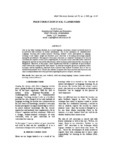Peer correction in ESL classrooms
Abstract
Like in any other learning situation, in a second language classroom a learner essentially needs to be provided with feedback on his/her performance. Due to the emergence of Communicative Language Teaching and Learner-centered Teaching, students’ active participation in language learning is now highly sought and therefore, peer correction is becoming increasingly popular among the practitioners. This paper re-views peer correction as a ‘popular’ technique to be used in classroom and explores several issues regarding this. It also places peer correction in the context of Bangladesh and tries to find out the effectiveness of the technique particularly for the classrooms of Bangladesh. Moreover, in this paper I have hypothesized that the acceptability of peer feedback varies between the young and the adult learners. In order for testing the general acceptability of this technique and the hypothesis, data have been collected from students at tertiary level as well as students from primary level. Finally, the students’ responses have been analyzed and discussed, and some recommendations have been provided regarding the practice of peer correction.

